height MAZDA MODEL MAZDASPEED 3 2008 Owners Manual (in English)
[x] Cancel search | Manufacturer: MAZDA, Model Year: 2008, Model line: MODEL MAZDASPEED 3, Model: MAZDA MODEL MAZDASPEED 3 2008Pages: 394, PDF Size: 7.62 MB
Page 18 of 394
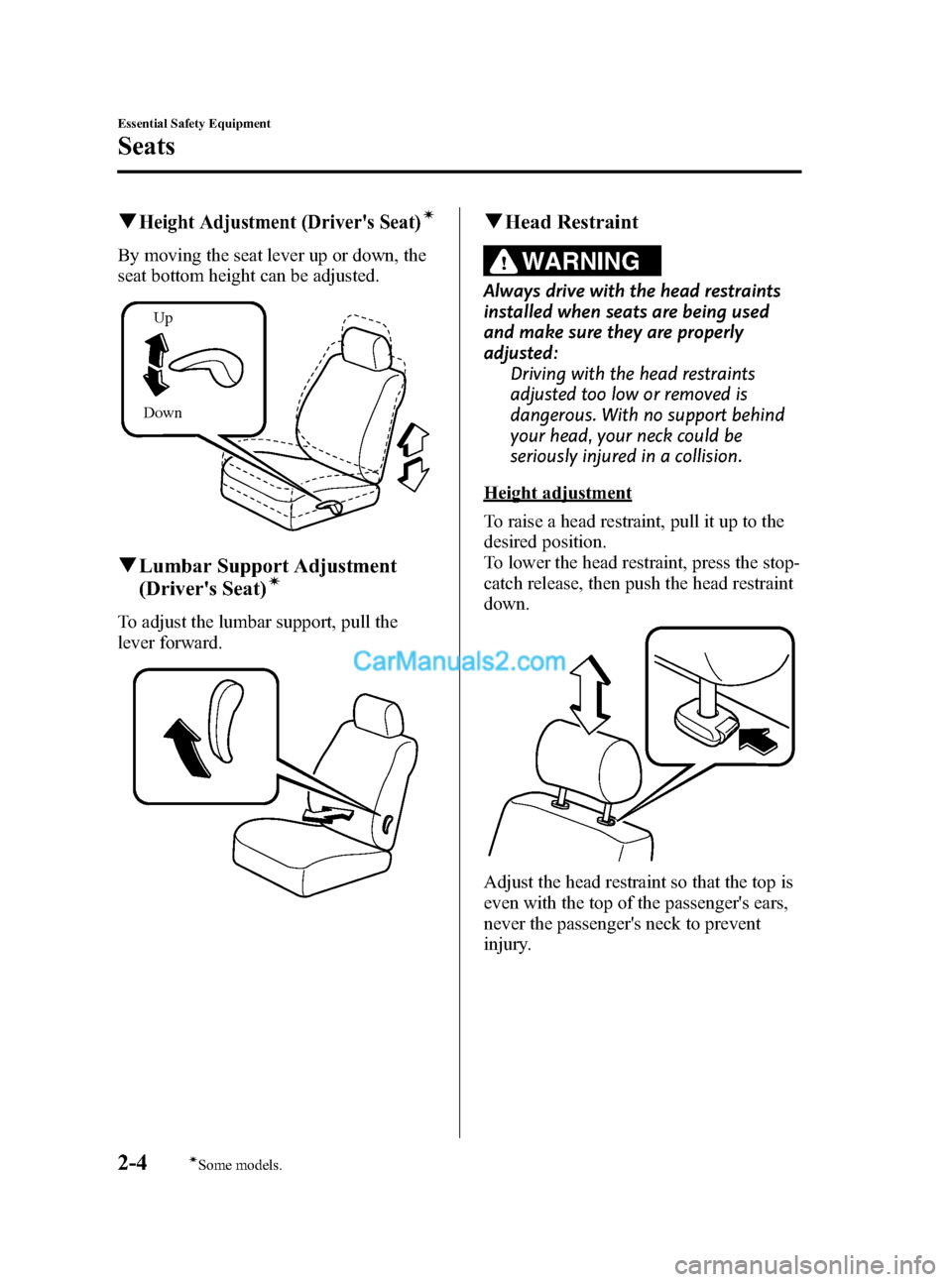
Black plate (18,1)
qHeight Adjustment (Driver's Seat)í
By moving the seat lever up or down, the
seat bottom height can be adjusted.
DownUp
qLumbar Support Adjustment
(Driver's Seat)í
To adjust the lumbar support, pull the
lever forward.
qHead Restraint
WARNING
Always drive with the head restraints
installed when seats are being used
and make sure they are properly
adjusted:
Driving with the head restraints
adjusted too low or removed is
dangerous. With no support behind
your head, your neck could be
seriously injured in a collision.
Height adjustment
To raise a head restraint, pull it up to the
desired position.
To lower the head restraint, press the stop-
catch release, then push the head restraint
down.
Adjust the head restraint so that the top is
even with the top of the passenger's ears,
never the passenger's neck to prevent
injury.
2-4
Essential Safety Equipment
íSome models.
Seats
Mazda3_8X41-EA-07F_Edition1 Page18
Wednesday, April 25 2007 1:4 PM
Form No.8X41-EA-07F
Page 22 of 394
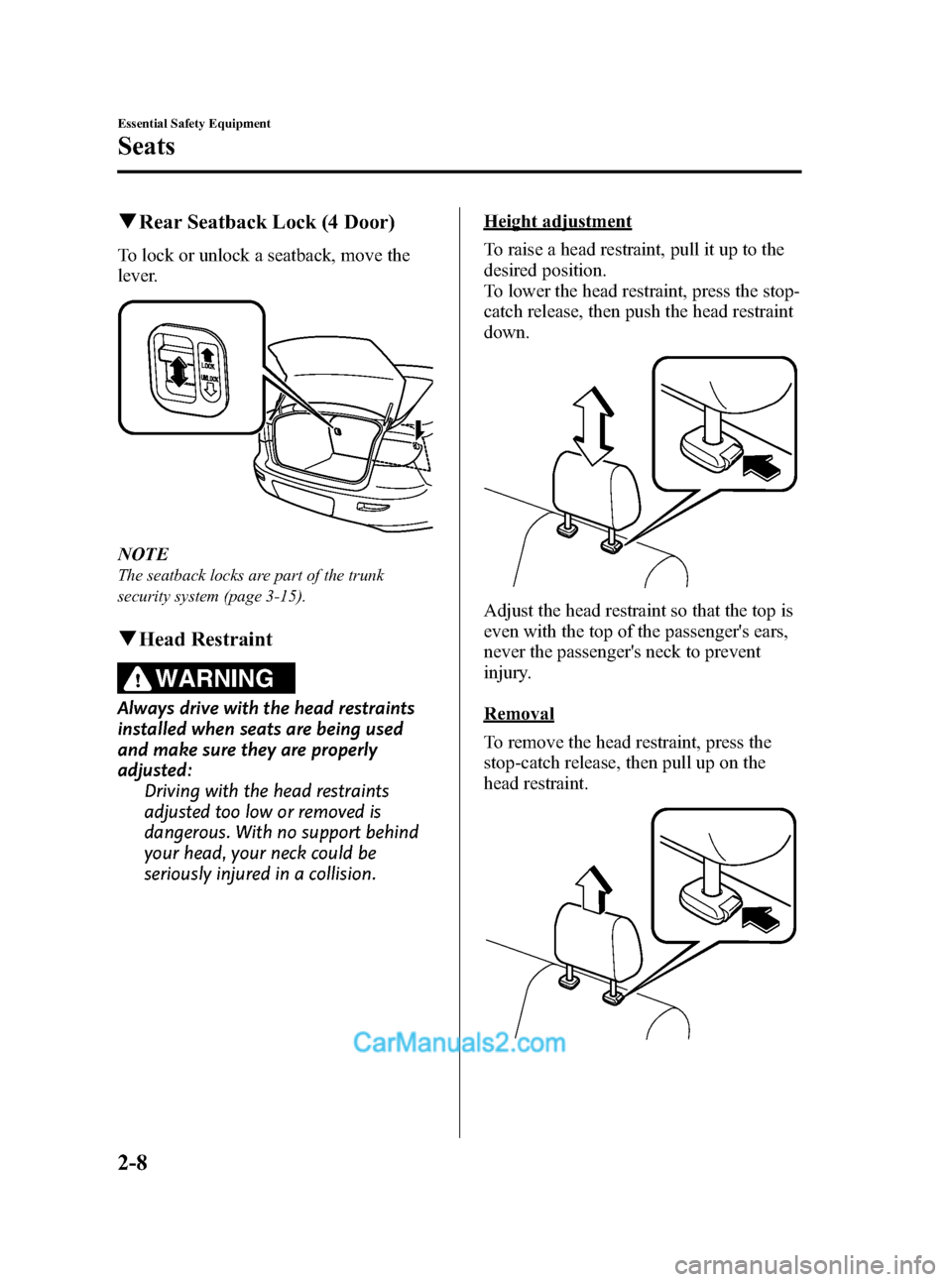
Black plate (22,1)
qRear Seatback Lock (4 Door)
To lock or unlock a seatback, move the
lever.
NOTE
The seatback locks are part of the trunk
security system (page 3-15).
qHead Restraint
WARNING
Always drive with the head restraints
installed when seats are being used
and make sure they are properly
adjusted:
Driving with the head restraints
adjusted too low or removed is
dangerous. With no support behind
your head, your neck could be
seriously injured in a collision.
Height adjustment
To raise a head restraint, pull it up to the
desired position.
To lower the head restraint, press the stop-
catch release, then push the head restraint
down.
Adjust the head restraint so that the top is
even with the top of the passenger's ears,
never the passenger's neck to prevent
injury.
Removal
To remove the head restraint, press the
stop-catch release, then pull up on the
head restraint.
2-8
Essential Safety Equipment
Seats
Mazda3_8X41-EA-07F_Edition1 Page22
Wednesday, April 25 2007 1:4 PM
Form No.8X41-EA-07F
Page 29 of 394
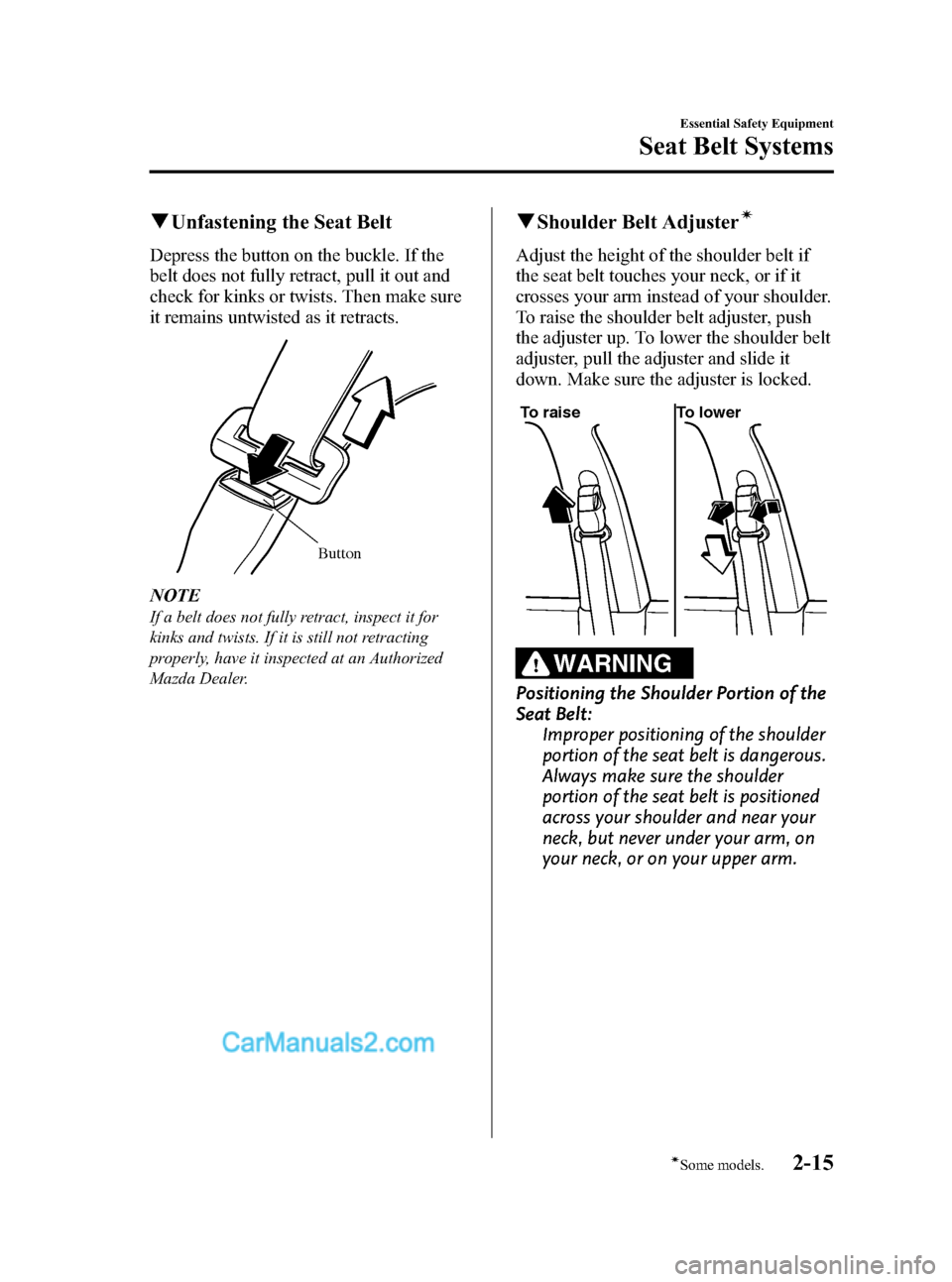
Black plate (29,1)
qUnfastening the Seat Belt
Depress the button on the buckle. If the
belt does not fully retract, pull it out and
check for kinks or twists. Then make sure
it remains untwisted as it retracts.
Button
NOTE
If a belt does not fully retract, inspect it for
kinks and twists. If it is still not retracting
properly, have it inspected at an Authorized
Mazda Dealer.
qShoulder Belt Adjusterí
Adjust the height of the shoulder belt if
the seat belt touches your neck, or if it
crosses your arm instead of your shoulder.
To raise the shoulder belt adjuster, push
the adjuster up. To lower the shoulder belt
adjuster, pull the adjuster and slide it
down. Make sure the adjuster is locked.
To raise To lower
WARNING
Positioning the Shoulder Portion of the
Seat Belt:
Improper positioning of the shoulder
portion of the seat belt is dangerous.
Always make sure the shoulder
portion of the seat belt is positioned
across your shoulder and near your
neck, but never under your arm, on
your neck, or on your upper arm.
Essential Safety Equipment
Seat Belt Systems
2-15íSome models. Mazda3_8X41-EA-07F_Edition1 Page29
Wednesday, April 25 2007 1:4 PM
Form No.8X41-EA-07F
Page 57 of 394
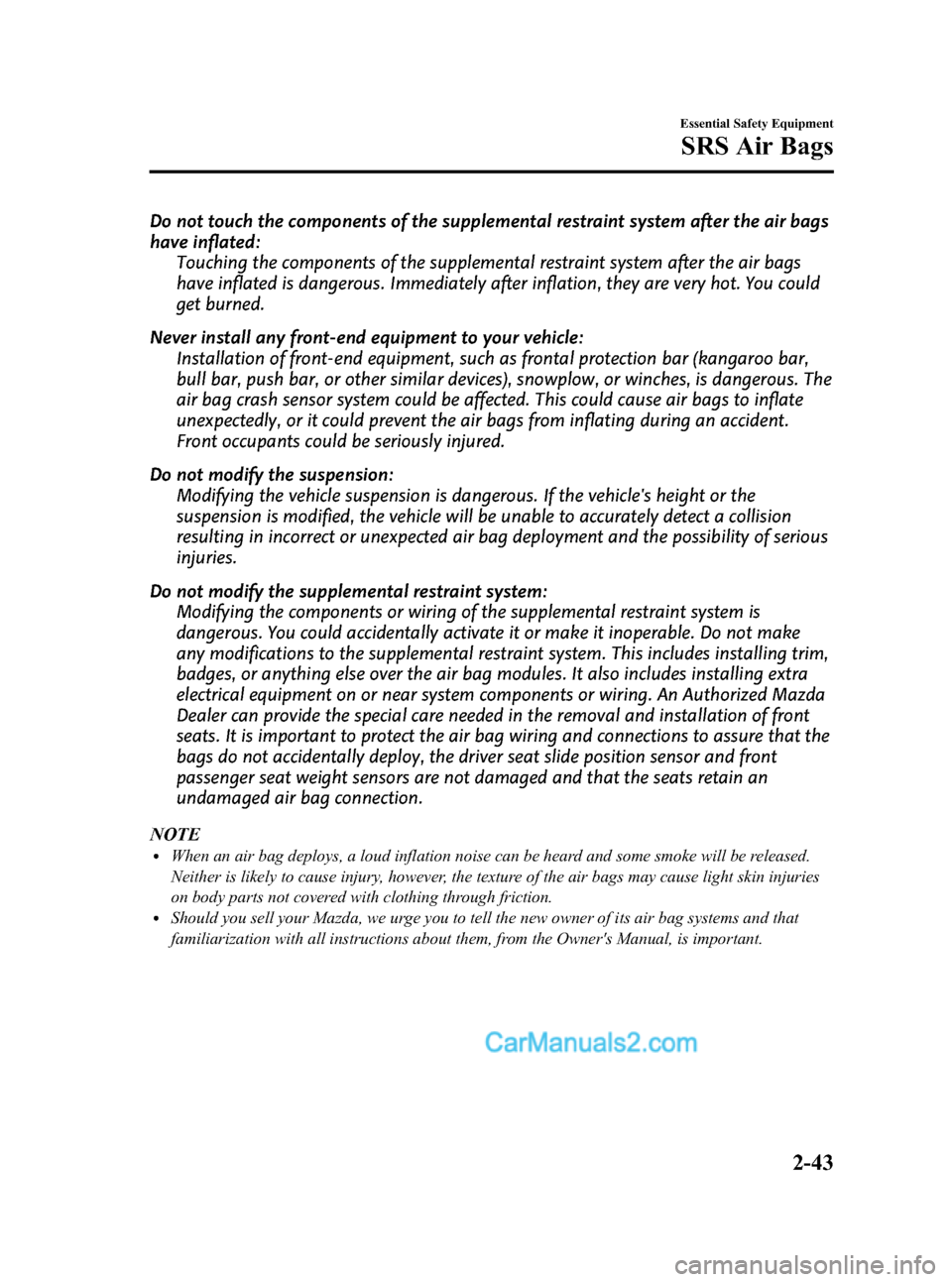
Black plate (57,1)
Do not touch the components of the supplemental restraint system after the air bags
have inflated:
Touching the components of the supplemental restraint system after the air bags
have inflated is dangerous. Immediately after inflation, they are very hot. You could
get burned.
Never install any front-end equipment to your vehicle:
Installation of front-end equipment, such as frontal protection bar (kangaroo bar,
bull bar, push bar, or other similar devices), snowplow, or winches, is dangerous. The
air bag crash sensor system could be affected. This could cause air bags to inflate
unexpectedly, or it could prevent the air bags from inflating during an accident.
Front occupants could be seriously injured.
Do not modify the suspension:
Modifying the vehicle suspension is dangerous. If the vehicle's height or the
suspension is modified, the vehicle will be unable to accurately detect a collision
resulting in incorrect or unexpected air bag deployment and the possibility of serious
injuries.
Do not modify the supplemental restraint system:
Modifying the components or wiring of the supplemental restraint system is
dangerous. You could accidentally activate it or make it inoperable. Do not make
any modifications to the supplemental restraint system. This includes installing trim,
badges, or anything else over the air bag modules. It also includes installing extra
electrical equipment on or near system components or wiring. An Authorized Mazda
Dealer can provide the special care needed in the removal and installation of front
seats. It is important to protect the air bag wiring and connections to assure that the
bags do not accidentally deploy, the driver seat slide position sensor and front
passenger seat weight sensors are not damaged and that the seats retain an
undamaged air bag connection.
NOTE
lWhen an air bag deploys, a loud inflation noise can be heard and some smoke will be released.
Neither is likely to cause injury, however, the texture of the air bags may cause light skin injuries
on body parts not covered with clothing through friction.
lShould you sell your Mazda, we urge you to tell the new owner of its air bag systems and that
familiarization with all instructions about them, from the Owner's Manual, is important.
Essential Safety Equipment
SRS Air Bags
2-43
Mazda3_8X41-EA-07F_Edition1 Page57
Wednesday, April 25 2007 1:4 PM
Form No.8X41-EA-07F
Page 306 of 394
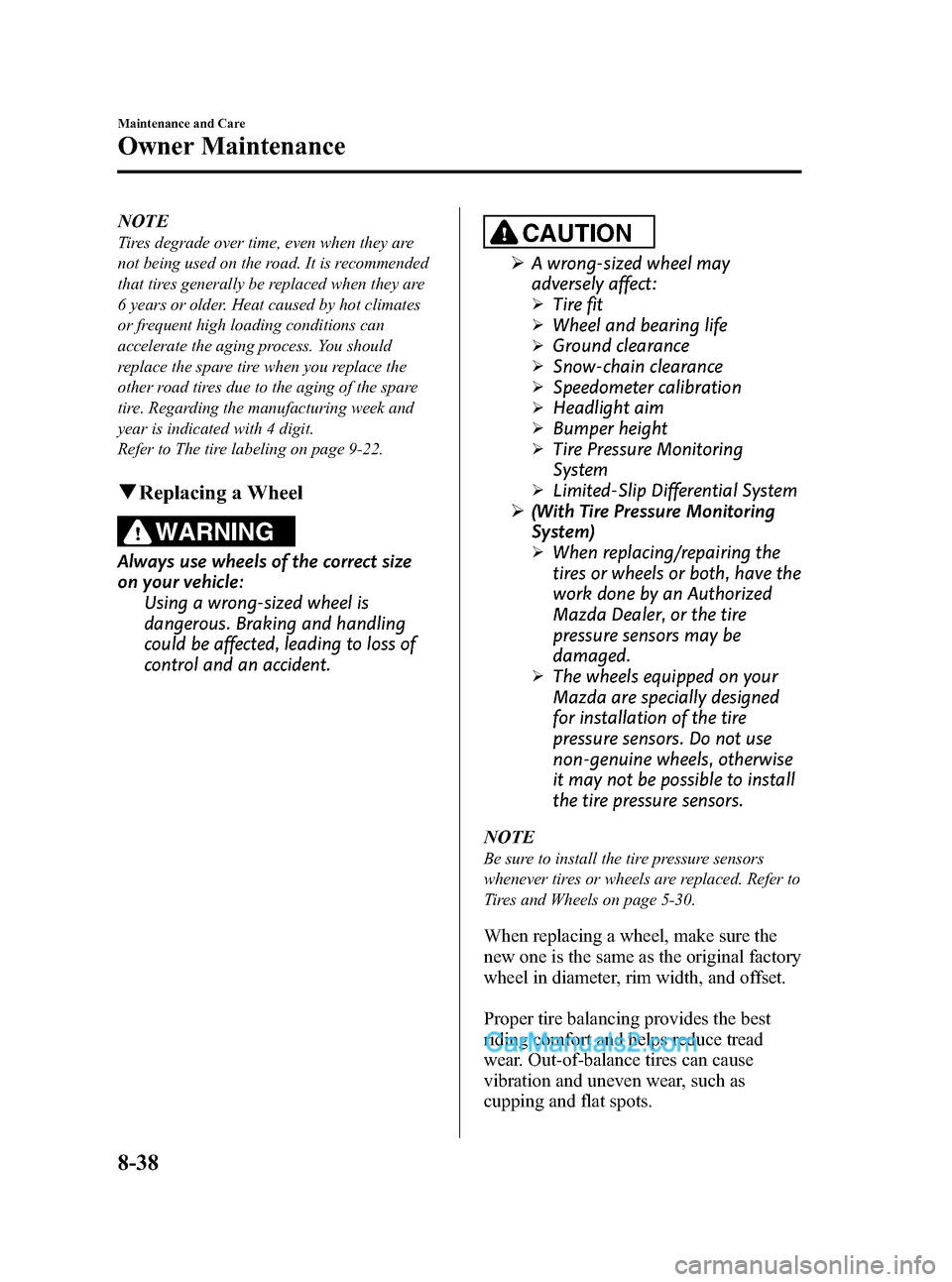
Black plate (306,1)
NOTE
Tires degrade over time, even when they are
not being used on the road. It is recommended
that tires generally be replaced when they are
6 years or older. Heat caused by hot climates
or frequent high loading conditions can
accelerate the aging process. You should
replace the spare tire when you replace the
other road tires due to the aging of the spare
tire. Regarding the manufacturing week and
year is indicated with 4 digit.
Refer to The tire labeling on page 9-22.
qReplacing a Wheel
WARNING
Always use wheels of the correct size
on your vehicle:
Using a wrong-sized wheel is
dangerous. Braking and handling
could be affected, leading to loss of
control and an accident.
CAUTION
ØA wrong-sized wheel may
adversely affect:
ØTire fit
ØWheel and bearing life
ØGround clearance
ØSnow-chain clearance
ØSpeedometer calibration
ØHeadlight aim
ØBumper height
ØTire Pressure Monitoring
System
ØLimited-Slip Differential System
Ø(With Tire Pressure Monitoring
System)
ØWhen replacing/repairing the
tires or wheels or both, have the
work done by an Authorized
Mazda Dealer, or the tire
pressure sensors may be
damaged.
ØThe wheels equipped on your
Mazda are specially designed
for installation of the tire
pressure sensors. Do not use
non-genuine wheels, otherwise
it may not be possible to install
the tire pressure sensors.
NOTE
Be sure to install the tire pressure sensors
whenever tires or wheels are replaced. Refer to
Tires and Wheels on page 5-30.
When replacing a wheel, make sure the
new one is the same as the original factory
wheel in diameter, rim width, and offset.
Proper tire balancing provides the best
riding comfort and helps reduce tread
wear. Out-of-balance tires can cause
vibration and uneven wear, such as
cupping and flat spots.
8-38
Maintenance and Care
Owner Maintenance
Mazda3_8X41-EA-07F_Edition1 Page306
Wednesday, April 25 2007 1:7 PM
Form No.8X41-EA-07F
Page 354 of 394
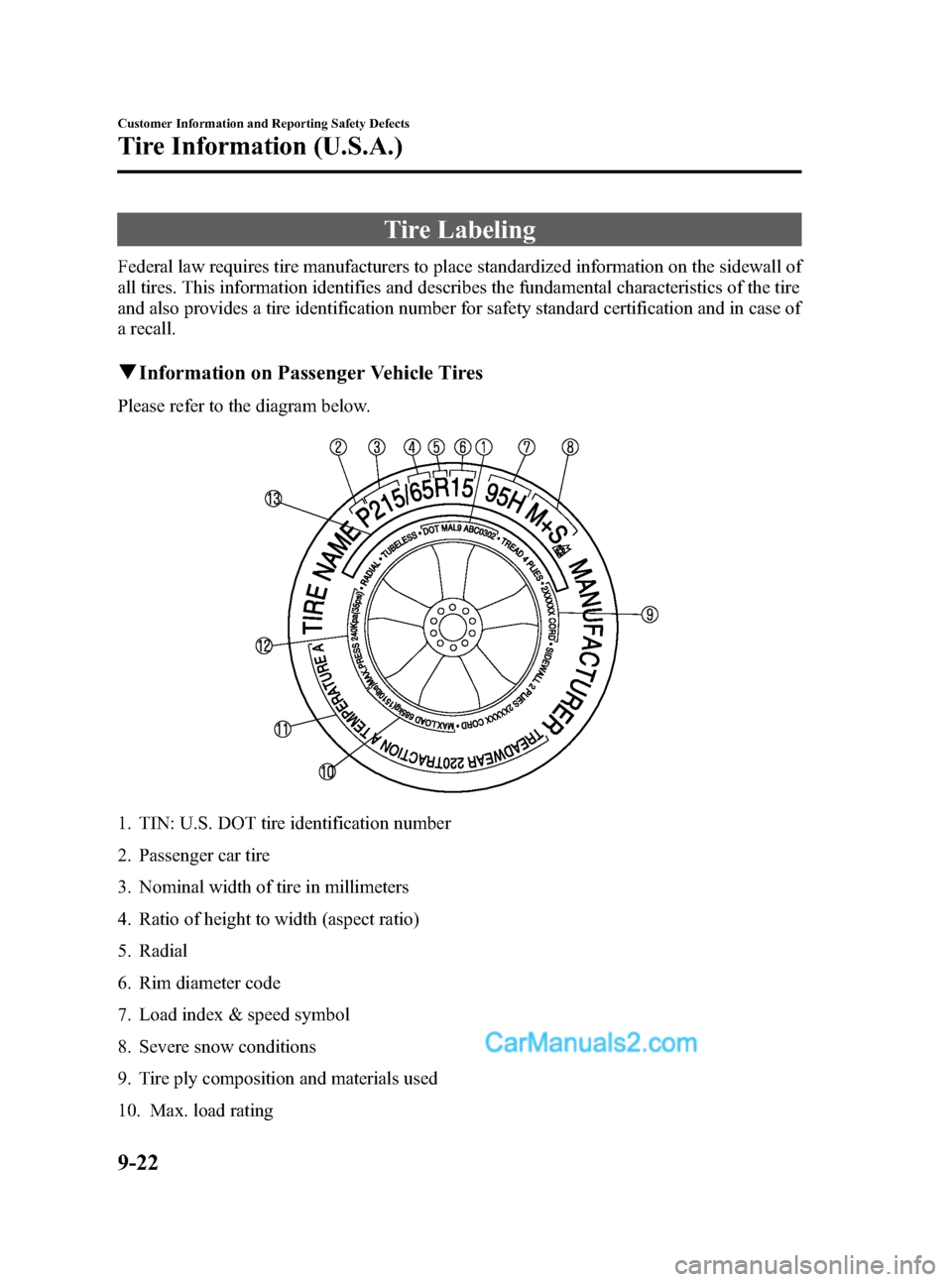
Black plate (354,1)
Tire Labeling
Federal law requires tire manufacturers to place standardized information on the sidewall of
all tires. This information identifies and describes the fundamental characteristics of the tire
and also provides a tire identification number for safety standard certification and in case of
a recall.
qInformation on Passenger Vehicle Tires
Please refer to the diagram below.
1. TIN: U.S. DOT tire identification number
2. Passenger car tire
3. Nominal width of tire in millimeters
4. Ratio of height to width (aspect ratio)
5. Radial
6. Rim diameter code
7. Load index & speed symbol
8. Severe snow conditions
9. Tire ply composition and materials used
10. Max. load rating
9-22
Customer Information and Reporting Safety Defects
Tire Information (U.S.A.)
Mazda3_8X41-EA-07F_Edition1 Page354
Wednesday, April 25 2007 1:7 PM
Form No.8X41-EA-07F
Page 355 of 394
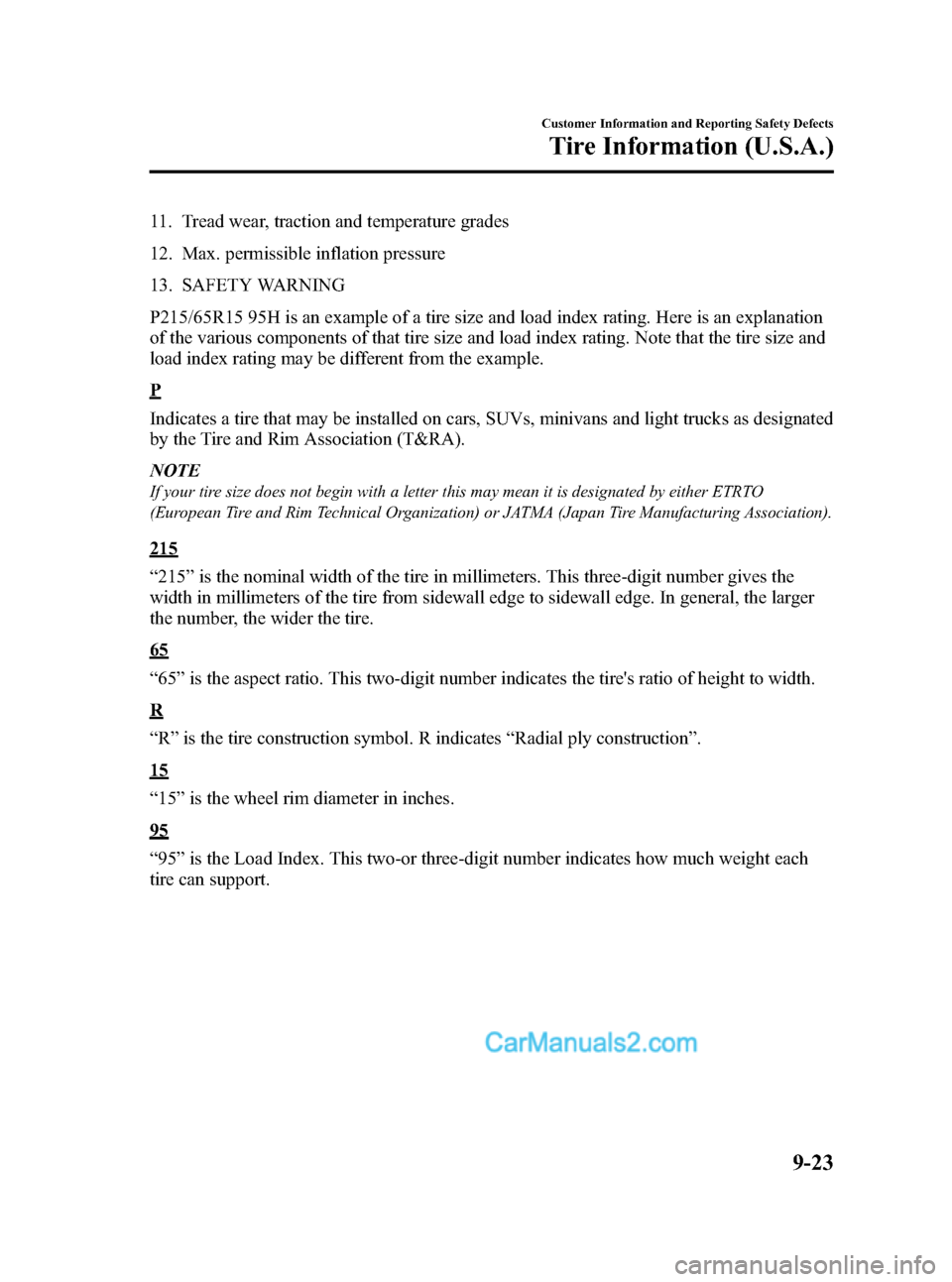
Black plate (355,1)
11. Tread wear, traction and temperature grades
12. Max. permissible inflation pressure
13. SAFETY WARNING
P215/65R15 95H is an example of a tire size and load index rating. Here is an explanation
of the various components of that tire size and load index rating. Note that the tire size and
load index rating may be different from the example.
P
Indicates a tire that may be installed on cars, SUVs, minivans and light trucks as designated
by the Tire and Rim Association (T&RA).
NOTE
If your tire size does not begin with a letter this may mean it is designated by either ETRTO
(European Tire and Rim Technical Organization) or JATMA (Japan Tire Manufacturing Association).
215
“215”is the nominal width of the tire in millimeters. This three-digit number gives the
width in millimeters of the tire from sidewall edge to sidewall edge. In general, the larger
the number, the wider the tire.
65
“65”is the aspect ratio. This two-digit number indicates the tire's ratio of height to width.
R
“R”is the tire construction symbol. R indicates“Radial ply construction”.
15
“15”is the wheel rim diameter in inches.
95
“95”is the Load Index. This two-or three-digit number indicates how much weight each
tire can support.
Customer Information and Reporting Safety Defects
Tire Information (U.S.A.)
9-23
Mazda3_8X41-EA-07F_Edition1 Page355
Wednesday, April 25 2007 1:7 PM
Form No.8X41-EA-07F
Page 358 of 394
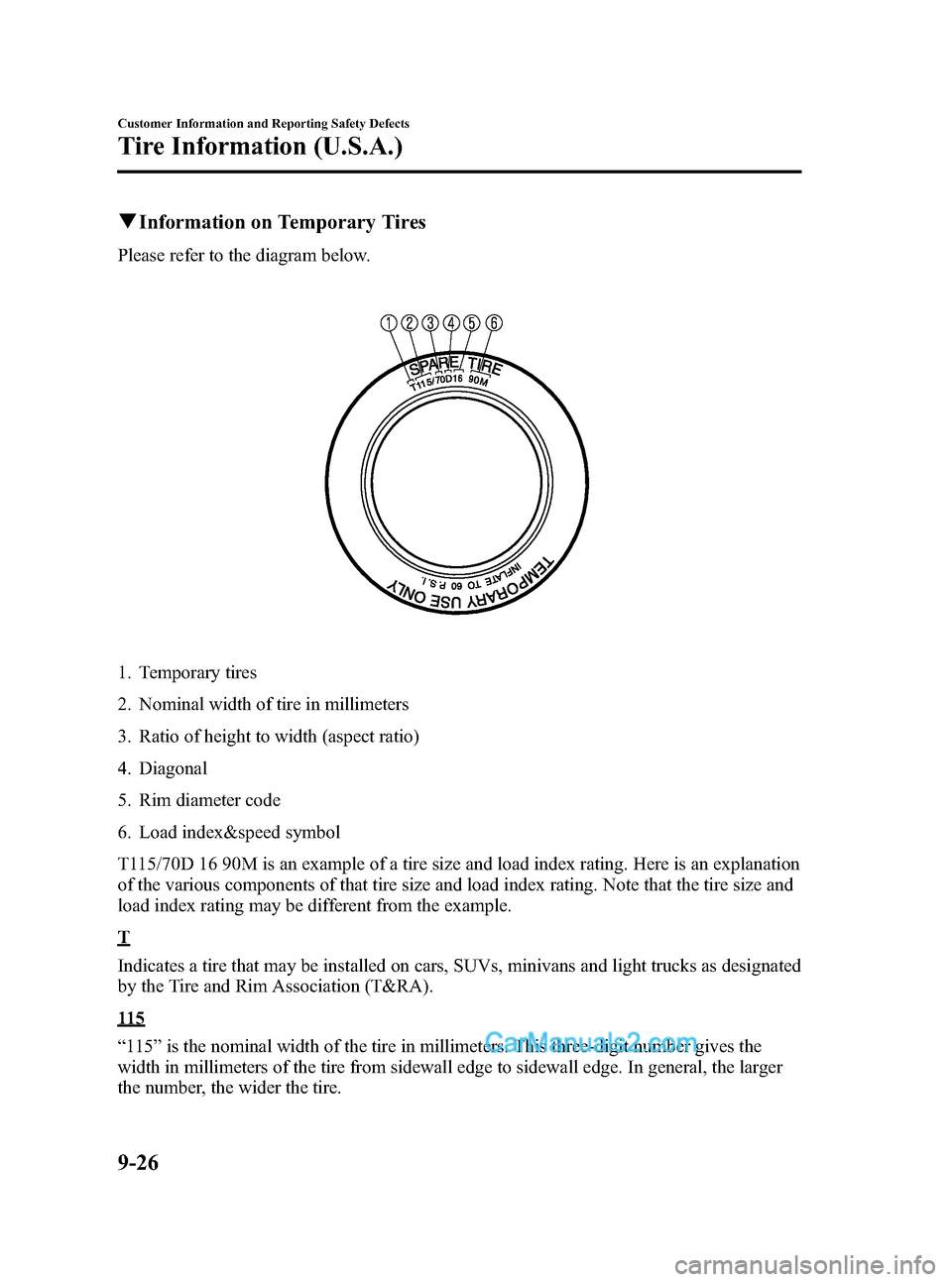
Black plate (358,1)
qInformation on Temporary Tires
Please refer to the diagram below.
1. Temporary tires
2. Nominal width of tire in millimeters
3. Ratio of height to width (aspect ratio)
4. Diagonal
5. Rim diameter code
6. Load index&speed symbol
T115/70D 16 90M is an example of a tire size and load index rating. Here is an explanation
of the various components of that tire size and load index rating. Note that the tire size and
load index rating may be different from the example.
T
Indicates a tire that may be installed on cars, SUVs, minivans and light trucks as designated
by the Tire and Rim Association (T&RA).
11 5
“115”is the nominal width of the tire in millimeters. This three-digit number gives the
width in millimeters of the tire from sidewall edge to sidewall edge. In general, the larger
the number, the wider the tire.
9-26
Customer Information and Reporting Safety Defects
Tire Information (U.S.A.)
Mazda3_8X41-EA-07F_Edition1 Page358
Wednesday, April 25 2007 1:7 PM
Form No.8X41-EA-07F
Page 359 of 394
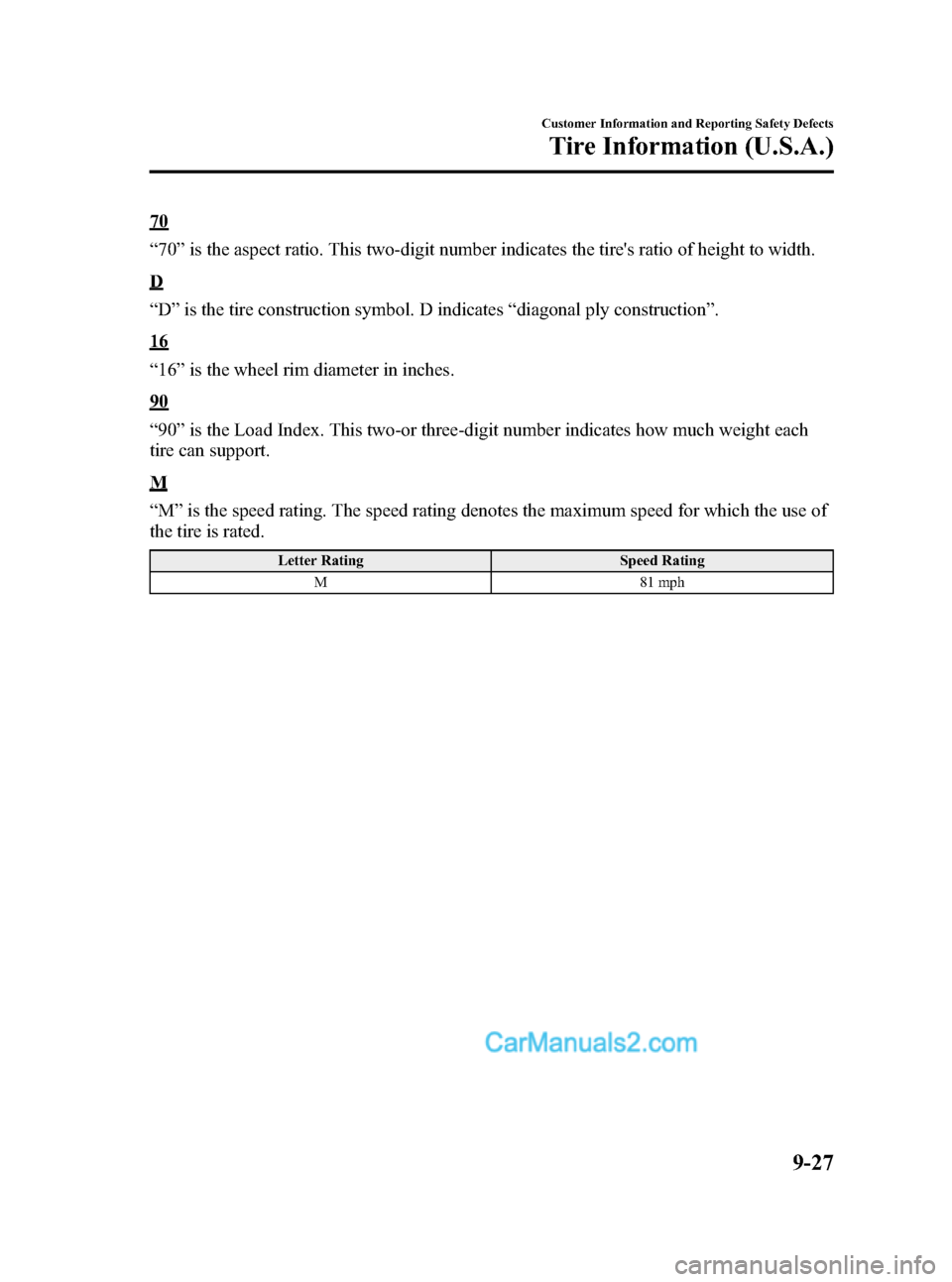
Black plate (359,1)
70
“70”is the aspect ratio. This two-digit number indicates the tire's ratio of height to width.
D
“D”is the tire construction symbol. D indicates“diagonal ply construction”.
16
“16”is the wheel rim diameter in inches.
90
“90”is the Load Index. This two-or three-digit number indicates how much weight each
tire can support.
M
“M”is the speed rating. The speed rating denotes the maximum speed for which the use of
the tire is rated.
Letter Rating Speed Rating
M 81 mph
Customer Information and Reporting Safety Defects
Tire Information (U.S.A.)
9-27
Mazda3_8X41-EA-07F_Edition1 Page359
Wednesday, April 25 2007 1:7 PM
Form No.8X41-EA-07F
Page 383 of 394
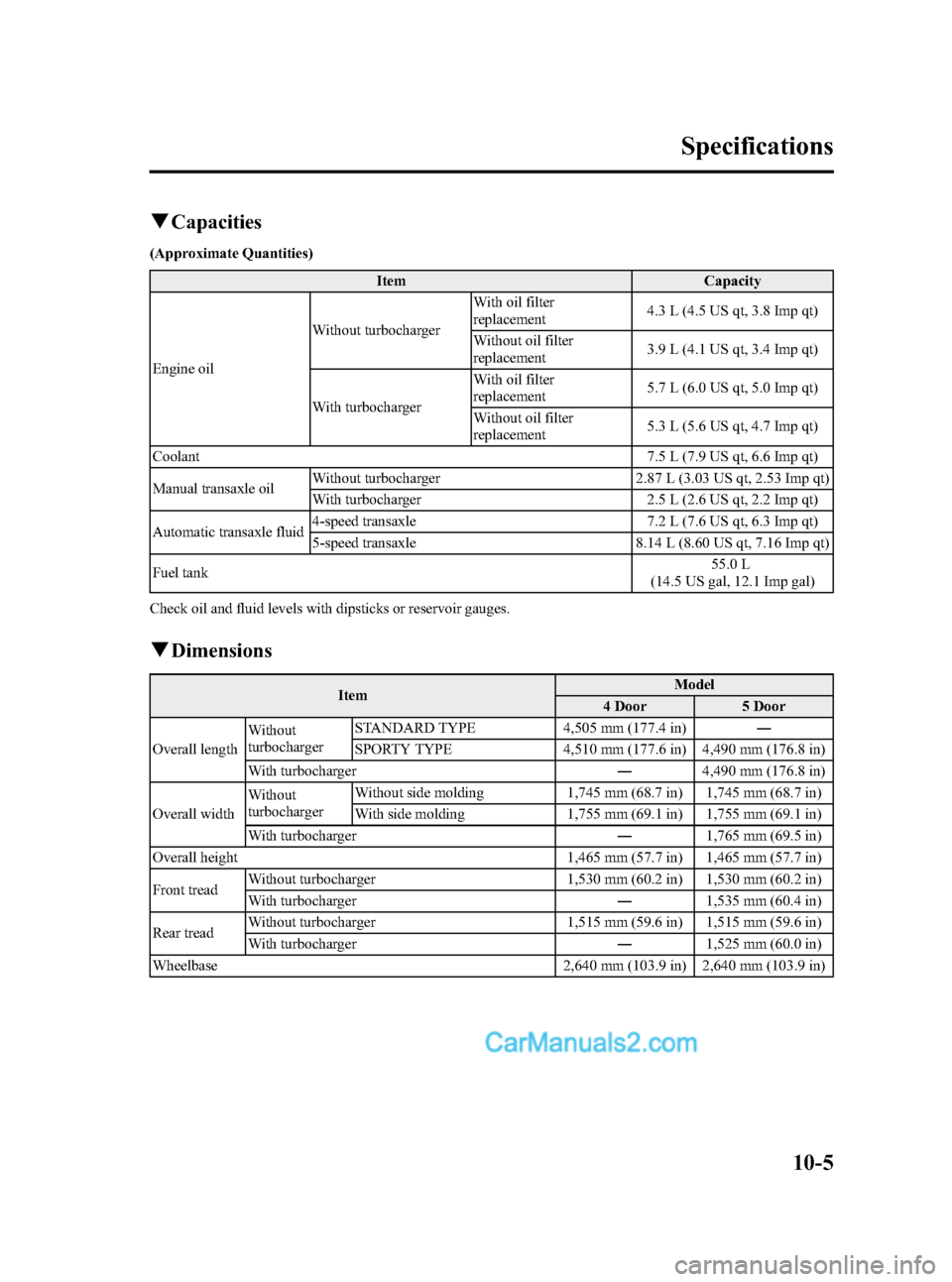
Black plate (383,1)
qCapacities
(Approximate Quantities)
Item Capacity
Engine oilWithout turbochargerWith oil filter
replacement4.3 L (4.5 US qt, 3.8 Imp qt)
Without oil filter
replacement3.9 L (4.1 US qt, 3.4 Imp qt)
With turbochargerWith oil filter
replacement5.7 L (6.0 US qt, 5.0 Imp qt)
Without oil filter
replacement5.3 L (5.6 US qt, 4.7 Imp qt)
Coolant 7.5 L (7.9 US qt, 6.6 Imp qt)
Manual transaxle oilWithout turbocharger 2.87 L (3.03 US qt, 2.53 Imp qt)
With turbocharger 2.5 L (2.6 US qt, 2.2 Imp qt)
Automatic transaxle fluid4-speed transaxle 7.2 L (7.6 US qt, 6.3 Imp qt)
5-speed transaxle 8.14 L (8.60 US qt, 7.16 Imp qt)
Fuel tank55.0 L
(14.5 US gal, 12.1 Imp gal)
Check oil and fluid levels with dipsticks or reservoir gauges.
qDimensions
ItemModel
4 Door 5 Door
Overall lengthWithout
turbochargerSTANDARD TYPE 4,505 mm (177.4 in)―
SPORTY TYPE 4,510 mm (177.6 in) 4,490 mm (176.8 in)
With turbocharger―4,490 mm (176.8 in)
Overall widthWithout
turbochargerWithout side molding 1,745 mm (68.7 in) 1,745 mm (68.7 in)
With side molding 1,755 mm (69.1 in) 1,755 mm (69.1 in)
With turbocharger―1,765 mm (69.5 in)
Overall height 1,465 mm (57.7 in) 1,465 mm (57.7 in)
Front treadWithout turbocharger 1,530 mm (60.2 in) 1,530 mm (60.2 in)
With turbocharger―1,535 mm (60.4 in)
Rear treadWithout turbocharger 1,515 mm (59.6 in) 1,515 mm (59.6 in)
With turbocharger―1,525 mm (60.0 in)
Wheelbase 2,640 mm (103.9 in) 2,640 mm (103.9 in)
Specifications
10-5
Mazda3_8X41-EA-07F_Edition1 Page383
Wednesday, April 25 2007 1:7 PM
Form No.8X41-EA-07F